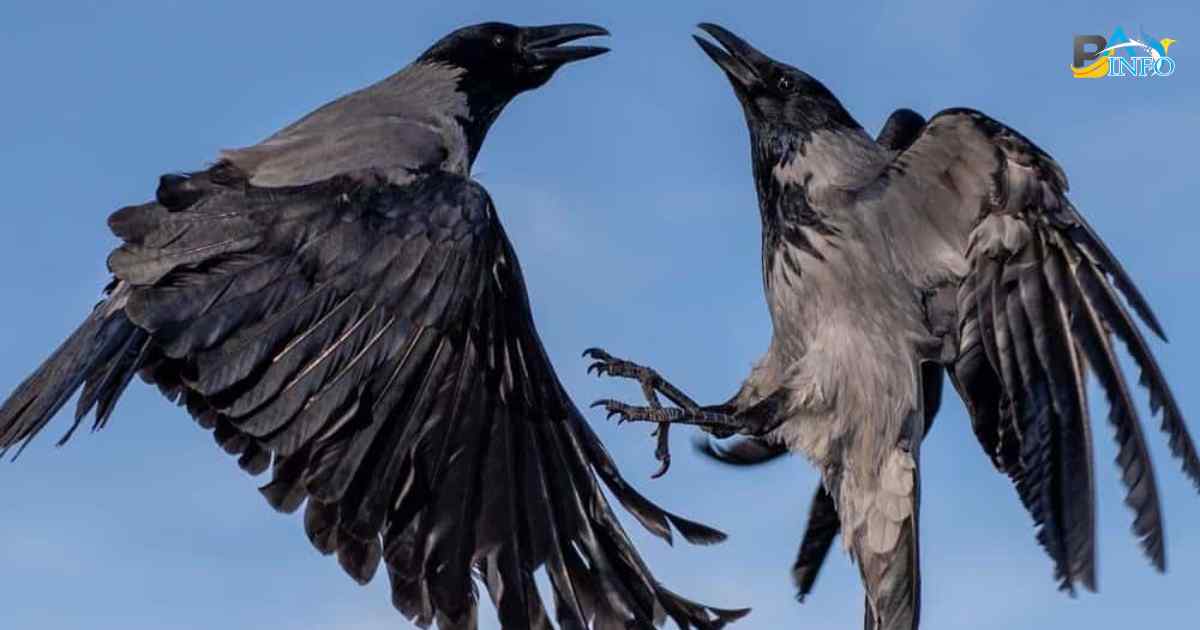Crows are omnivorous birds known to opportunistically prey on smaller birds, supplementing their diet with a variety of food sources including insects, small mammals, and even carrion.
Picture a bustling avian community where crows soar with a certain cunning grace. Among the myriad questions that arise in this avian theatre, one query stands out: Do Crows Eat Other Birds? Delving into the mysteries of avian behaviour, we uncover the fascinating truth behind the crow’s dietary habits and its potential impact on other feathered inhabitants.
The intricate web of nature, the dietary habits of crows offer a glimpse into the complexities of avian ecology. Despite their omnivorous nature, crows occasionally target smaller birds, demonstrating their adaptability and opportunistic feeding behaviours. Understanding the dynamics of predator-prey interactions among birds sheds light on the delicate balance of ecosystems they inhabit.
Common Types of Birds Crows Eat
Among the common types of birds crows prey upon are smaller songbirds such as sparrows, finches, and robins, often targeting fledglings or weakened individuals. Additionally, crows have been observed scavenging on the nests of other bird species, seizing the opportunity for an easy meal.
Sparrows: Common Prey
Crows exhibit a notable preference for sparrows, often swooping down to snatch unsuspecting individuals. Their agile flight and keen eyesight make them adept hunters, particularly when targeting smaller songbirds like sparrows.
Vulnerable Fledglings: Easy Targets
Fledgling birds, in their early stages of flight, become easy prey for crows. These inexperienced flyers often fall victim to the opportunistic nature of crows, highlighting the harsh realities of survival in the avian world.
Robins and Finches: On the Crow’s Menu
Robins and finches also fall within the culinary repertoire of crows. While these birds may seem agile and alert, they too become targets, especially during moments of vulnerability such as nest-building or feeding their young.
Crows Eating Birds Eggs
Crows are notorious for raiding the nests of other birds to feast on their eggs, often causing significant disruptions to local bird populations. Their cunning and resourcefulness enable them to locate and exploit vulnerable nests, posing a persistent threat to breeding success among various avian species.
Nest Robbery: A Common Behaviour
Crows exhibit a well-documented behaviour of raiding the nests of other birds to consume their eggs. This opportunistic feeding strategy provides crows with a rich source of nutrients during breeding seasons when food demands are high.
Impact on Avian Populations
The predation of bird eggs by crows can have detrimental effects on the populations of various avian species. The loss of eggs can disrupt breeding cycles, reduce reproductive success, and ultimately lead to declines in local bird populations.
Nesting Strategies Under Siege
Birds employ various nesting strategies to protect their eggs from predators, but crows’ intelligence and persistence often outmatch these defences. Despite efforts such as camouflage and nest concealment, crows can detect and exploit vulnerabilities in nesting sites.
Conservation Challenges
The predation of bird eggs by crows presents challenges for conservationists striving to maintain healthy avian populations. Understanding the dynamics of predator-prey interactions and implementing strategies to mitigate crow predation are crucial steps in safeguarding vulnerable bird species.
Contextual Factors
Contextual factors surrounding crow predation on other birds include environmental conditions, availability of alternative food sources, and competition with other predators. Understanding these factors is essential for comprehending the nuanced dynamics of avian ecosystems and the intricate relationships between predator and prey species.
Environmental Dynamics
Environmental factors such as habitat type, climate variations, and seasonal changes play pivotal roles in shaping the dynamics of crow predation. Crows adapt their foraging behaviours based on these environmental cues, which influence the availability and accessibility of prey species.
Food Source Availability
The abundance and diversity of food sources in a given ecosystem significantly impact crow predation patterns. When preferred prey species are scarce, crows may intensify their predation on other birds, including eggs and nestlings, to meet their nutritional needs.
Interactions with Competitors and Prey
Crows often interact with other avian predators and prey species within their habitats. Competition for resources, territorial disputes, and predator-prey relationships influence the frequency and intensity of crow predation on other birds. Understanding these complex interactions provides valuable insights into the ecological dynamics of avian communities.
Crows as Opportunistic Feeders
Crows exhibit remarkable opportunism in their feeding behaviours, adapting to diverse environments and exploiting various food sources. Their omnivorous diet includes scavenging carrion, hunting small mammals, foraging for insects, and occasionally preying on other birds, reflecting their adaptive prowess in securing sustenance.
Diverse Dietary Choices
Crows showcase their opportunistic nature by embracing a diverse range of dietary options. From scavenging carcasses to picking off insects, these adaptable birds capitalise on a broad spectrum of food sources, showcasing their ability to thrive in various ecosystems.
Carrion Consumption Strategies
Crows are renowned for their role as scavengers, efficiently capitalising on carrion. Their keen intelligence allows them to locate and exploit these food sources, contributing to ecological balance by aiding in the swift removal of animal remains.
Adapting to Urban Environments
Crows’ opportunistic feeding extends to urban landscapes where they’ve learned to exploit human-made environments. From foraging in garbage bins to pilfering scraps, their ability to adapt and take advantage of human activities underscores their versatility as opportunistic feeders in both natural and anthropogenic settings.
Impact on Ecosystems
The impact of crows on ecosystems is multifaceted, influencing both biotic and abiotic components. Their role as scavengers helps maintain cleanliness by disposing of carrion, yet their predation on other bird species can disrupt local avian populations and alter community dynamics, highlighting the intricate balance within ecosystems.
Predation Dynamics
Crows’ predatory behaviour can significantly affect ecosystem dynamics, particularly in bird communities. By preying on smaller bird species and raiding nests for eggs, crows can disrupt breeding success and alter population structures, potentially leading to cascading effects throughout the ecosystem.
Carrion Cleanup and Nutrient Cycling
While their predatory actions can disrupt avian populations, crows also play a crucial role in ecosystem health as scavengers. By consuming carrion, they contribute to nutrient cycling and help maintain the cleanliness of the environment, preventing the spread of disease and promoting overall ecosystem balance.
Balancing Act
Understanding the nuanced impact of crows on ecosystems requires a balanced perspective. While their predatory behaviour can pose challenges for certain bird species, their role as scavengers and their ability to regulate carrion contribute to the intricate web of interactions that sustain healthy ecosystems. Achieving a harmonious balance between these contrasting roles is essential for preserving biodiversity and ecosystem stability.
FAQs
Do crows kill and eat other birds?
Yes, crows do kill and eat other birds, including smaller species and their eggs.
Would a crow kill a pigeon?
While it’s less common, a crow might kill a pigeon if the opportunity arises and if it perceives the pigeon as a potential source of food or competition.
Why do crows pick on other birds?
Crows may pick on other birds for various reasons, including competition for resources, territory defence, or as a predatory behaviour.
Do crows attack but jays?
Crows may attack jays if they perceive them as threats or competitors, particularly in situations involving territorial disputes or resource competition.
Conclusion
The question “Do crows eat other birds?” unveils the intricate dynamics of avian ecology and the multifaceted role of crows within ecosystems. While crows are known to opportunistically prey on smaller birds and raid nests for eggs, their behaviour reflects the complexities of predator-prey interactions and the delicate balance of nature.
However, it’s imperative to recognize that crows’ dietary habits extend beyond predation, encompassing scavenging and foraging behaviours that contribute to ecosystem health. Despite their role as predators, crows play a vital role in nutrient cycling, carrion cleanup, and maintaining ecological balance.
Thus, understanding the nuances of crow behaviour and their impact on avian communities underscores the need for holistic conservation efforts. By recognizing the importance of preserving biodiversity and mitigating anthropogenic pressures, we can strive to foster coexistence between crows and other bird species while safeguarding the integrity of our ecosystems.

Welcom to https://birdsaboutinfo.com. Our content is for general information purposes. While we aim for accuracy, use it at your own risk. Seek professional advice for specific concerns. We’re not responsible for external links or the outcome of using our information. Some content may contain affiliate links. We may update this Disclaimer.











